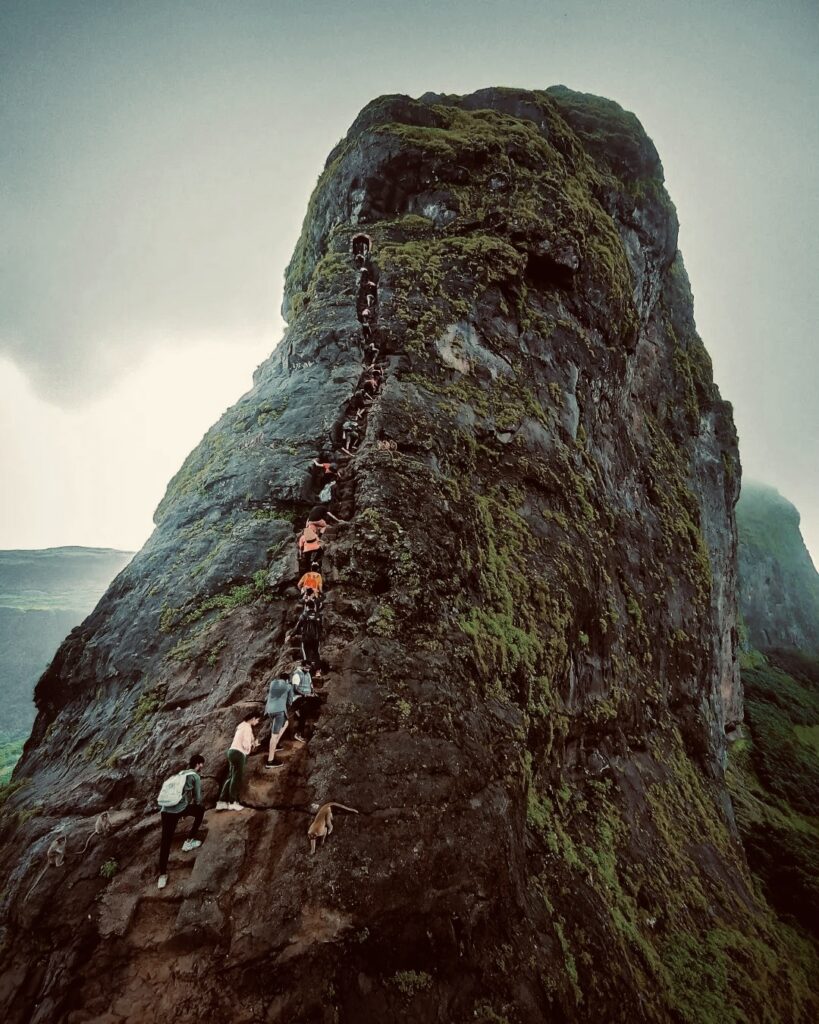Table Of This Blog

All About Harihar Fort Nashik Trek
Harihar Fort appears to be rectangular from its base village. It is built on a triangular prism of rock. Its three faces and two edges are vertical at 90 degrees. The third edge towards the west is inclined at an angle of 75 degrees. A one-meter wide rocky staircase with niches in it is carved out for ascending and descending the Hari Har Gad Fort.
There are 117 steps in all. After you climb the first rocky staircase to the main entrance, we walk below an overhang with a sheer drop. Again, one has to climb a set of steep stairs with niches, then pass through a staircase inside the rock-like Peth Fort or Kothaligad Fort, and then reach the top of the Fort. The view from the top is excellent. After climbing these steps, we get up to the entrance door.
The Fort Harihar Nashik has got a tapering plateau with a raised level in the middle. There is a small temple of Lord Hanuman and Lord Shiva on the plateau. A small pond is there in front of this temple. Water from this pond can be used for drinking.
Making headway from here, we come across a palace that has two rooms in it. 10 to 12 people can be accommodated in this palace. One of the vertical drops of Fort Harihar facing the Nirgudpada village is called “Scottish Kada”, perhaps because it was climbed for the first time in November 1986 by Doug Scott, the legendary Himalayan mountaineer, and it took him two days to do the climb. This cliff is about 170 metres in height. Harihar fort images are available in our photo gallery.
Harihar Trek Details or Harihar Fort Information
- Harihar Fort Height is 3676 feet above sea level
- Hari Har Gad Fort Region is Trymbakeshwar
- Harihar Trek difficulty is tough
- Harihargad Trek endurance is High
- Harihar fort base village is Nirgudpada
- Harihar Fort Nashik trek distance is 3.5 km one way.
Harihar Fort Detailed Information
Harihar Fort is a historic fort located in the Nashik district of Maharashtra, India. The Sahyadri fort lies at an altitude of 3,676 feet from sea level. It was constructed on the edge of a hill that looks rectangular from the village below; during the Yadava dynasty, the Harihar fort was built upon a triangular mountain with nearly vertical elevations.
The Harihar Fort Nashik is known for its steep steps that lead directly to the top of this rock-solid structure. People like taking pictures on these stairs because they are so steep, almost eighty degrees.
Tucked into the secluded quietness of this ancient-era Fort are statues that represent Lord Shiva, Lord Hanuman, and Nandi, as well as a calm little pond!
On a clear day, the view from the Fort Harihar can take your breath away. You have a great vantage point to see forts here, such as Bhaskargad Maharashtra or Basgad, Anjaneri fort, Brahmagiri Trek Nashik, Bhandardurg, Vaitarna lake, and Utwad fort, to name a few forts near Nashik.
Leopards and other large animals, vultures, falcons, hawks, and eagles are regularly spotted in the jungle below the forest. Harihar fort photos are open in our photo gallery.
Interesting Harihar fort history
In 1818, a British officer named Briggs captured the Harihargad Maharashtra. The British strategy was to use cannons to destroy the defences and access roads to the forts. As a consequence, many Forts, steps, routes and trails were destroyed by the British. The splendour of Harihar fort’s rock-cut steps, on the other hand, astounded him. Officer Briggs left the Fort intact and did not destroy the iconic steps of the Harihar Fort Nashik.
Harihar Fort, also known as Harish Fort or Harishgad, is a historic hill fort located in Maharashtra, India. It is situated in the Nashik district, near the town of Trimbak. The fort has a significant place in the history of the region and has been witness to various historical events and rulers. Here’s a brief overview of the interesting history of Harihar Fort:
Ancient and Medieval Periods:
Harihar Fort dates back to the 6th century, during the rule of the Yadava dynasty. It was initially constructed to serve as a watchtower to guard the trade routes that passed through the region. Over the centuries, the fort came under the control of various dynasties, including the Bahmani Sultanate and the Mughals.
Maratha Period:
During the Maratha rule, Harihar Fort gained prominence as it was strategically located and offered a vantage point to monitor and control the surrounding areas. The Maratha king Shivaji Maharaj, known for his military prowess, captured the fort in 1670 from the Mughals. The fort was used to keep an eye on the nearby Trimbak Fort and to safeguard the region against potential threats.
British Era:
The fort came under British control during the 19th century. It lost much of its strategic importance by this time, and its military significance declined. The British used the fort as a place of rest and respite for their officers. However, they also dismantled certain parts of the fort to prevent it from being used by any potential rebels or freedom fighters.
Architecture and Features:
Harihar Fort is known for its unique architecture and rock-cut steps that lead to the top. The steps are steep and narrow, requiring careful navigation. At the top, there are remnants of structures that once served as military lookout posts and living quarters. The fort offers panoramic views of the surrounding landscape, including the Trimbak range and the nearby Brahma Giri mountain.
Harihar Fort stands as a testament to the region’s historical significance and the architectural ingenuity of its builders. It is a place where history, adventure, and natural beauty converge, making it an interesting destination for travelers and explorers.
Things to keep an eye on the Harihar Fort Trek
The Fort’s famous steps lead to the top of the Fort. Climbing the nearly vertical staircase leading to Harihar fort’s summit is the most thrilling aspect of the hike.
On the rocks, these small steps have been created. There are notches carved into the rock-cut steps that help you keep hold while climbing up till the first door and help you from falling out as you climb.
If you’re terrified of heights, don’t look back while climbing the stairs. It’s terrifying to realize how many stairs you’ve already climbed. On the other hand, looking behind you allows you to see the universe unfolding in front of you! The vertical views are just out of the world for adventure seekers.
The Sahyadri mountain range is a sight to behold – observing the Maharashtra forts from this vantage point will entirely transport you into a different world.
An astonishing view of the Sahyadri range’s peaks will amaze you when you reach the top. If you’re trekking in the rainy season, look out for lush grassy mountains and fortresses all around! You can see forts in Nashik like Durg bhandar, Bhaskargad or Basgad, Utwad fort, Anjaneri fort, Brahmagiri hill and other renowned places from here.
Harihar Trek Trail Brief Information
The Harihar Trek is a popular and moderately challenging hiking trail located near Nashik, Maharashtra, India. This trek offers a perfect blend of adventure and scenic beauty, making it a favorite among nature enthusiasts and adventure seekers.
- Starting Point: The trek typically starts from the base village of Nirgudpada, which is accessible by road from Nashik.
- Initial Ascent: The trail commences with a gentle climb through lush green fields and local hamlets, providing a glimpse of rural life in the region.
- Rock-cut Stairs: As the trek progresses, the trail transforms into a series of steep rock-cut stairs, demanding careful navigation. The sturdy iron chains installed along the route offer much-needed support.
- Narrow Ridge: The ascent leads to a narrow ridge with panoramic views of the surrounding landscape, including the nearby Trimbak range and the expansive greenery.
- Pinnacle Climb: The highlight of the trek is the steep climb to the pinnacle, which is a thrilling experience. The pinnacle’s unique shape resembling a staircase adds to its allure.
- Rappelling: The descent from the pinnacle involves rappelling, adding an exciting element to the trek. Local guides and necessary equipment ensure safety during this phase.
- Cave Exploration: On the way back, trekkers often explore the nearby caves, adding a touch of history and mystique to the adventure.
- Temple Visit: After completing the trek, a visit to the Harihar Temple at the base offers a chance to seek blessings and appreciate the religious significance of the region.
- Duration: The trek typically takes around 3 to 4 hours to complete, depending on the pace of the group and weather conditions.
- Best Time: The ideal time for this trek is during the post-monsoon and winter months (October to February), as the weather is pleasant and the surroundings are vibrant.
- Essentials: Trekkers are advised to wear comfortable trekking attire and sturdy footwear. Carrying sufficient water, energy snacks, and a first aid kit is essential. Sunscreen and hats are recommended to protect against sun exposure.
- Guides and Permissions: It’s recommended to hire a local guide familiar with the terrain, as the path can be challenging at times. Additionally, some treks may require obtaining necessary permissions from local authorities.
The Harihar Trek presents an excellent opportunity to experience a blend of adventure, spirituality, and natural beauty, making it a memorable excursion for trekkers of varying skill levels.
Related Post:
Bisi Bele Bath Recipe | Just In 10 Easy Steps.
Tilkut Recipe | Just In 6 Easy Steps.
Bafauri Recipe | Just In 5 Easy Steps.
Red Wine Granita Recipe | Just In 8 Easy Steps.
Lychee Granita Recipe | Just In 8 Easy Steps.
Dragon Fruit Granita Recipe | Just In 8 Easy Steps.
-
Harihar Fort Nashik | Best Fort In India.
All About Harihar Fort Nashik Trek Harihar Fort appears to be rectangular from its base village. It is built on…


